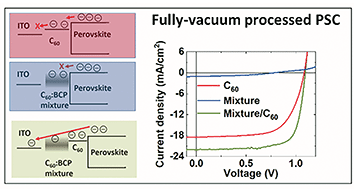Themed collection Perovskite solar cells – Topic Highlight

Perspectives on the mechanical robustness of flexible perovskite solar cells
This perspective highlights recent advances in improving the mechanical robustness of FPSCs and prospects to clarify the mechanism between the mechanical behavior and the photoelectric performance.

Energy Adv., 2023,2, 355-364
https://doi.org/10.1039/D2YA00303A
Synthetic approaches for perovskite thin films and single-crystals
Halide perovskites are compelling candidates for the next generation of photovoltaic technologies owing to an unprecedented increase in power conversion efficiency and their low cost, facile fabrication and outstanding semiconductor properties.

Energy Adv., 2023,2, 1075-1115
https://doi.org/10.1039/D3YA00098B
Enhancing perovskite solar cell efficiency and stability through the incorporation of BDAI2 and DMPDAI2
This research explores the incorporation of 2D materials, BDAI2 and DMPDAI2, into perovskite solar cells, demonstrating enhanced efficiency and stability in the resulting devices.

Energy Adv., 2024,3, 552-557
https://doi.org/10.1039/D3YA00496A
Rear textured p-type high temperature passivating contacts and their implementation in perovskite/silicon tandem cells
High temperature passivating p-type contacts on textured surfaces with iVOC up to 725 mV and contact resistance below 90 mΩ cm2. 28.25% tandem PK/c-Si solar cells rear side textured with high temperature passivating contacts.

Energy Adv., 2023,2, 1818-1822
https://doi.org/10.1039/D3YA00048F
An efficient Buchwald–Hartwig amination protocol enables the synthesis of new branched and polymeric hole transport materials for perovskite solar cells
Efficient and sustainable Buchwald-Hartwig amination enables the synthesis of new branched and polymeric HTL materials for perovskite solar cells with performances comparable with those of Spiro-OMeTAD.

Energy Adv., 2022,1, 398-401
https://doi.org/10.1039/D2YA00135G
Simple approach for an electron extraction layer in an all-vacuum processed n-i-p perovskite solar cell
C60:BCP (bathocuproine) mixture, significantly improved electron extraction in an all-vacuum processed n-i-p perovskite solar cell.

Energy Adv., 2022,1, 252-257
https://doi.org/10.1039/D1YA00084E
Stabilizing all-inorganic CsPbI3 perovskite films with polyacrylonitrile for photovoltaic solar cells
The N atom in the side chain of the PAN skeleton coordinated with the exposed Pb atom on the CsPbI3 perovskite, which effectively passivated the defects of CsPbI3 crystal grains, and the PCE of the CsPb3I3-based PSCs improved from 14.36% to 16.21%.

Energy Adv., 2022,1, 62-66
https://doi.org/10.1039/D1YA00068C
Life cycle assessment of low-dimensional materials for perovskite photovoltaic cells
Perovskite solar cells integrated with lower dimensional materials can outperform the environmental performance of conventional solar photovoltaic technologies such as crystalline silicon, CIGS, and CdTe with shorter lifetimes.

Energy Adv., 2024,3, 800-811
https://doi.org/10.1039/D3YA00540B
An ambient process for hole transport layer-free highly stable MAPbI3 by addition of MACl for efficient perovskite solar cells
An ambient process for the fabrication of HTL-free carbon-based perovskite solar cells at room temperature with the addition of an optimized amount of MACl into the perovskite precursor solution.

Energy Adv., 2024,3, 442-450
https://doi.org/10.1039/D3YA00500C
Decal Ni mesh to enhance the conductivity of carbon back contacts in dye sensitized and perovskite solar cells
Decal of a nickel mesh prepared by photolithography-assisted electroplating on carbon counter-electrode of dye sensitized and perovskite solar cells improves the conductivity of the back contact and the performance of the devices.

Energy Adv., 2024,3, 307-315
https://doi.org/10.1039/D3YA00476G
Strategies to improve the mechanical robustness of metal halide perovskite solar cells
We demonstrate the fragility of perovskite solar cells is typically in the small molecule electron transport layer and show strategies for designing more mechanically and operationally robust devices by improving the layers and interfaces.

Energy Adv., 2024,3, 273-280
https://doi.org/10.1039/D3YA00377A
An Fe3O4 based hole transport bilayer for efficient and stable perovskite solar cells
Insertion of a thin inorganic Fe3O4 layer between perovskite and spiro-OMeTAD improves charge extraction and device efficiency and also boosts device shelf-life stability.

Energy Adv., 2023,2, 1905-1914
https://doi.org/10.1039/D3YA00014A
Design and development of a low-cost imidazole-based hole transporting material for perovskite solar cells
Low-cost and facile synthesis routes of hole-transporting materials (HTMs) are promising approaches to minimize the total cost of perovskite solar cells (PSCs) on both laboratory and commercial scales.

Energy Adv., 2023,2, 1693-1701
https://doi.org/10.1039/D3YA00111C
Dopant-free small-molecule hole-transport material for low-cost and stable perovskite solar cells
Dopant-free hole-transporting materials (HTMs) aim to improve efficiency and stability simultaneously, and are a promising direction for efficient perovskite solar cells (PSCs).

Energy Adv., 2023,2, 1521-1530
https://doi.org/10.1039/D3YA00367A
Role of antisolvent temperature and quaternary ammonium cation-based ionic liquid engineering in the performance of perovskite solar cells processed under air ambient conditions
Low-temperature of the chlorobenzene antisolvent and trimethylpropylammonium bis(trifluoromethanesulfonyl)imide ionic liquid at the TiO2/perovskite interface improves the device efficiency and stability.

Energy Adv., 2023,2, 1155-1165
https://doi.org/10.1039/D3YA00065F
A chlorinated polythiophene-based polymer as a dopant-free hole transport material in perovskite solar cells
We report a chlorine-substituted polythiophene-based, dioxobenzodithiophene-containing conjugated polymer (P2T-Cl) as a promising dopant-free hole transport material in lead halide perovskite solar cells.

Energy Adv., 2023,2, 1030-1035
https://doi.org/10.1039/D3YA00113J
Low-intensity low-temperature analysis of perovskite solar cells for deep space applications
Perovskite solar cells (PSCs) are studied in low-intensity low-temperature (LILT) conditions before and after low energy proton irradiation to characterize device performance at deep space mission-relevant light intensities and temperatures.

Energy Adv., 2023,2, 298-307
https://doi.org/10.1039/D2YA00218C
Perovskite device efficiency is a poor predictor for the number of citations a paper will get
Beeswarm plot for over 7000 papers with original perovskite solar cell data, where the area of the circles corresponds to the number of citations the papers had obtained by 2022-03-26 and the colour reflects the top device efficiency in each paper.

Energy Adv., 2022,1, 1035-1040
https://doi.org/10.1039/D2YA00261B
Enhancing the lifetime of inverted perovskite solar cells using a new hydrophobic hole transport material
The lifetime of inverted PSCs is extended by employing for the first time the hydrophobic conjugated polymer PIDTTDQ. The optimized PIDTTDQ device shows an increased PCE due to the improved HTL/Perovskite interface while having enhanced moisture, light and thermal stability.

Energy Adv., 2022,1, 312-320
https://doi.org/10.1039/D2YA00067A
Low-temperature annealed methylammonium-free perovskites prepared under ambient conditions in C electrode-based perovskite solar cells
A study of the optimization of methylammonium (MA) free perovskite compositions, targeted for their application in hole transport layer (HTL) free perovskite solar cells with a carbon electrode (C-PSCs), is presented.

Energy Adv., 2022,1, 76-86
https://doi.org/10.1039/D1YA00037C
About this collection
Energy Advances features cutting-edge science at the forefront of energy technology with a particular focus on emerging materials and methods. This collection highlights some of our recent publications on perovskite solar cells.
Our multidisciplinary journal seeks further contributions in this area, including material development and film fabrication, interface engineering, investigating the chemical and environmental stability of perovskite solar cells and device architecture and engineering.
To contribute your research, please visit our submission platform.